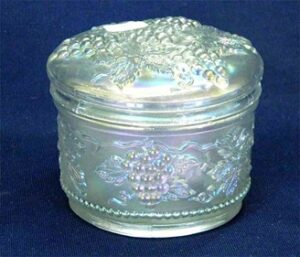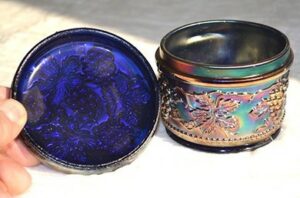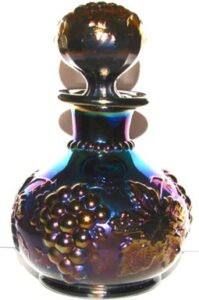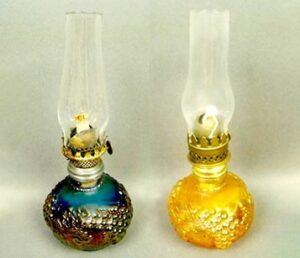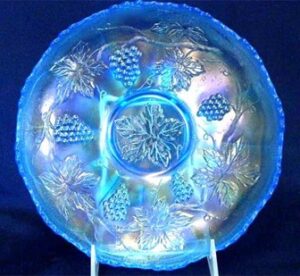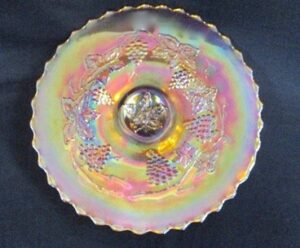Dugan and Diamond Vintage
By Dr. Larry Keig
This is a revised and updated version of an article that appeared in the March 2013 edition of The Carnival Pump.
Dugan-Diamond’s Vintage is neither a variant of Northwood’s venerated Grape and Cable nor of Fenton’s less acclaimed, but equally realistic, Vintage. Researchers have known for decades this is a post-1909 Indiana, Pa., pattern. Yet confusion persists and misinformation abounds.
Vintage was likely introduced during the Dugan carnival years (1909-1913) or, in the case of most shapes, later, after the company was restructured as Diamond Glass Works in July 1913. If this were an early pattern, it probably would have been produced in peach opal, Dugan’s signature color, and more extensively in oxblood and white, two other pre-eminent colors of the Dugan era. Only one item is known in the essentially opaque amethyst and in the earliest of the pastels.
Dresser Set Items
Perfume bottles with stoppers, powder jars with lids. That’s it when it comes to Dugan and Diamond dresser sets. No cologne bottles, no hatpin holders, no pin or dresser trays.
Powder Jars. Three grape clusters and six leaves, over which three of the grape clusters are superimposed, along with vines and tendrils, wind their way around the jar. The grapes cover most of the three mold lines, the other leaves situated between clusters. Below the plant life is a band of beads which encircles the jar.
Alternating clusters of grapes and leaves, three of each, are the main elements on the lid, which also includes a fourth cluster dead center. The top diameter of the jar is approximately three and one-half inches. The lid fit diameter is about three and three-fourth inches. Jars are often found without lids, indicating that over time many of the fragile tops were broken or lost.
Powder jars have been confirmed in marigold, amethyst, oxblood, white, and, now verified, cobalt blue and marigold over powder blue. Marigold are easily acquired. Amethyst and oxblood are somewhat more difficult to find. White are harder yet to come by, with few having sold over the past quarter century. Cobalt had been said to exist, but until one was pictured in the December 12, 2018, edition of the HOC Mailing List, the matter had not been officially settled.
The cobalt is a recent find. As Dave Noyes, its new owner explains: “I bought it on eBay and was the only bidder which just blew me away. I put in a quite high bid right near the end of the auction because I knew I wanted it and figured there would be a flurry of late activity. Nothing happened, the auction ended with me being the only bidder.”
Dave, who bought the jar for $125 this past December from an Arizona seller, was not the first 2018 buyer. In October this seller had purchased it on eBay from someone in North Carolina who may have found it at a local estate sale. One wonders what the Arizona dealer paid for it if Dave was able to get it for the modest listing price.
The hard-to-find white powder jars hardly ever have resplendent color. The iridescence on the illustrated example, sold by Seeck Auctions in 2012, is prettier than most.
Rumored to exist for years, the cobalt blue Vintage powder jar was confirmed when Dave Noyes pictured it this past December on the HOC Mailing List.
Reported even more recently is a marigold over powder blue powder jar with metal lid. Kathi and Galen Johnson displayed it at the 2019 Tampa Bay convention. They bought it from Pam Mills, once WWWCGA president, who likely found it in the UK.
The jar is likely late Diamond as the “marigolds on” were made in the late ‘20s. Manufacture of the lid was no doubt outsourced. Whether it was made in the U.S. or the British Isles is not known. A photo was unavailable at article submission deadline date.
The availability of oxblood and white, base colors primarily associated with Dugan, not Diamond, suggests that powder jars were probably the earliest Vintage items made. It seems likely they were introduced in 1911 or 1912, while Thomas E.A. Dugan was still in the corner office, rather than in the teens, after the company had come under new management.
Perfume Bottles. Vintage perfumes are tiny compared to Northwood Grape colognes. Three single grape clusters and six leaves (two leaves per group) are found alternating around the most bulbous area of the three and one-half inch bottle, not including the stopper. A band of beads provides filler above the botanical elements. (Northwood employed cable, instead of beads, as filler above the fruit and leaves on its Grape and Cable cologne). A solid glass stopper, with a single grape cluster on its top, fits into the opening of the bottle.
Perfume bottles have been confirmed only in marigold and amethyst. Thus, it is probable they were produced in the early teens, post-Dugan, but before pastel blue was made. It is possible a cobalt perfume bottle and stopper will surface sometime, as a companion to the blue powder jar. It should also be noted that, although no complete white perfume has been confirmed, a white stopper is rumored to exist.
The brightly iridized amethyst perfume bottle was sold by Seeck Auctions in March 2015. The price realized was reflective of just how pretty it is.
A guess is that other dresser set items were on the drawing board before the firm’s namesakes left town, that powder jars and perfume bottles were the first of several projected pieces of a full dresser set, but that the plan was scuttled by the new management team.
Lamps
Dugan’s Vintage was long considered a maker-unmarked Northwood pattern. The unmarked tiny grape lamp, for decades referred to as the Northwood Grape and Cable miniature, is actually Dugan or Diamond. The bases are the Vintage perfume bottle. Lamps, like jars without shades, are available in marigold and amethyst. The illustrated pair sold at the 2018 Tampa Bay convention auction conducted by the Burns Auction Service.
Dave Doty has suggested that Dugan or Diamond may have “bought the burners and shades and installed them before sale or [that] the bases were bought by a wholesaler who installed them” (HOC Mailing List, January 11, 2019). Hard to know which.
Vintage miniature lamps are hard to find. The illustrated pair shown—one amethyst, the other marigold sold at a Burns auction in April 2018.
Dome-Footed Bowls and Plates
Inelegantly and likely hastily designed, Vintage dome-footed pieces feature six grape clusters and five leaves (one a double) on the broad interior expanse and a single leaf in the center. Vines and tendrils connect fruit and leaves, creating what is in effect a wreath— except for an area where there is “a break in the pattern” (that is, void of leaf). The outer edge is serrated.
But there is no need to count clusters and leaves or to note the break to know this is a Dugan or Diamond product, as these bowls and plates are invariably dome-footed. They are also almost always plain-backed, the infinitesimal number with a Compass exterior—the pattern found regularly on the reverse of Dugan’s Heavy Grape and Ski Star—are exceptions to the rule. None have Wide Panel backs. (Collar-based Vintage bowls and plates with Wide Panel secondaries are Fenton.)
Bowls. Bowls range from eight and one-half to nine inches in diameter. While the amethyst are the most often offered, they sell infrequently. Cobalt, marigold, and green show up even less often. (Some so-called Dugan or Diamond Vintage have turned out to be Fenton, so don’t be fooled into thinking that they are plentiful.) Bowls in pastel blue—cerulean or Vesuvius, monikers Diamond assigned to this (these) shade(s)—also surface every now and then. The celeste blue is the most sought after color in this pattern. The green vary tremendously in shade. The most desirable are the dark intense green. Lighter shades (including one that is essentially olive, another resembling Imperial’s helios) are less attractive. While scarce, Dugan Vintage is the pattern seen most often in green. White are listed as available in books and on websites, but there is no record of any having sold.
Most bowls are broadly ruffled. While a nut bowl has also been reported, I have not been able to verify that it is flat-ruffled with interior ruffles that stand perpendicular to the bottom of the base, factors which distinguish a Dugan-Diamond nut bowl from conventionally shaped bowls.
Plates. Plates range from nine to nine and one-half inches in diameter. They have been reported only in marigold and amethyst. Neither surfaces often. It is possible cobalt and green also exist. The colors in which bowls and plates are known, except dark green, suggest they are early Diamond, not Dugan. Because none of the amethyst are dark enough to qualify as oxblood, and none have been confirmed in white, a Dugan attribution can probably be ruled out. The time frame in which dome-footed items were produced remains unclear, although it can be said with certainty until at least 1916 or 1917 when Diamond introduced its pastel blue.
Desirability
Dugan-Diamond Vintage is not, by any stretch of the imagination, top-rated in terms of desirability. Yet several Vintage pieces are in demand. Why are some eagerly sought out, others pretty much steered clear of?
Desirability is a complex phenomenon. It includes rarity but is not limited to numbers alone. It also includes elegance or uniqueness of design, the base color, quality of color (base or surface, iridescence, and, where applicable, opalescence), range of colors available (usually the greater the range, the more in demand), and size and shape (the larger and smaller and the more unusual generally more desirable than the more conventional). The “common wisdom” of a collector oligarchy often enters in as well.
Vintage powder jars and perfume bottles are, for the most part, more in demand than dome-footed pieces, especially bowls. But even these (except for the recently reported cobalt) are not as coveted as they might be because their iridescence is rarely something you’d text a friend about. Plates and pastel blue bowls pique interest because they are hard to come by, even though their color and iridescence are often underwhelming. A complete perfume in white or a bowl in ice green, regardless of color quality, would surely rank at the top of the desirability scale.
Celeste blue Vintage bowls are not rare, but they are highly desirable. This beautiful example was sold in 2012 by Seeck Auctions.
Vintage plates are highly variable in quality of base color and iridescence. The nice one illustrated was sold by Wroda Auctions in March 2014.
I wish authors of articles and posters on websites would abstain from perpetuating errors on what is Dugan-Diamond Vintage and what are grape patterns made by other glassmakers. And I also wish writers would refrain from reporting colors as sure things that are unlikely to exist. Forty years have elapsed since the provenance of this Dugan-Diamond pattern was literally unearthed in western Pennsylvania. While other salient information has emerged more recently, these details are anything but cutting-edge findings.
This article first appeared in the ICGA Pump in the March 2019 issue and is reprinted with permission.

